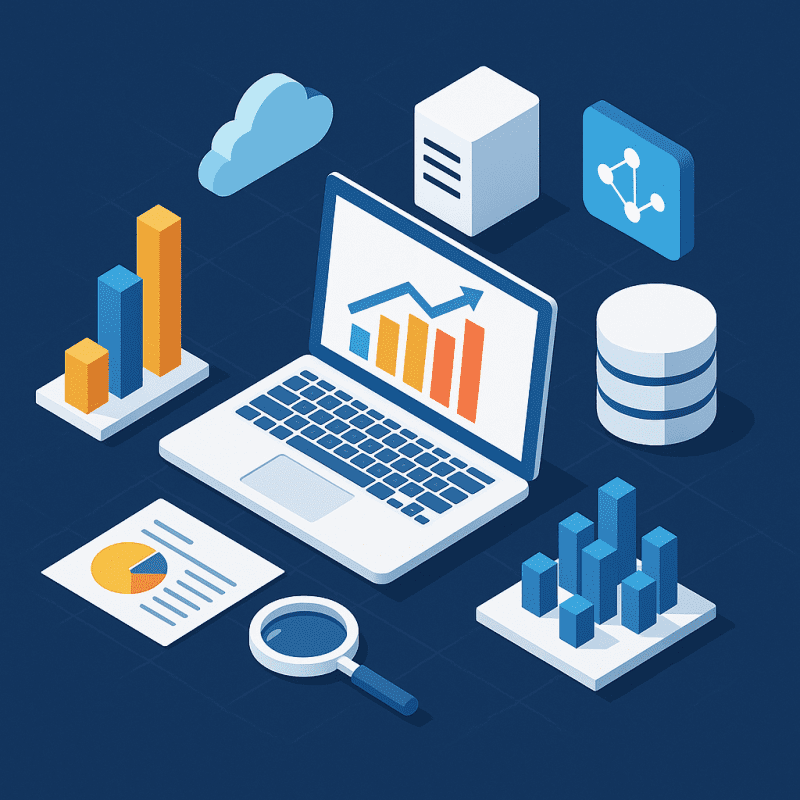Table of Contents Show
Everyone loves to say, “Data is the new oil.” It’s catchy. It sounds modern. But here’s a blunt reality check: most organizations are drilling in the same few wells – web analytics dashboards, CRM reports, social media stats.
Yes, those numbers are useful. But they’re not the whole story.
The most valuable insights are often buried in places you’re not even looking. They’re scattered across systems, tucked into forgotten reports, or hiding in subtle patterns no one’s bothered to connect.
This article is about the gold mine of data you’re probably ignoring. It’s the data that, if you took the time to harness it, could help you delight customers, boost efficiency, avoid disasters, and leapfrog your competitors.
Let’s dig in.
What Is “Overlooked” Data?
Before we start listing examples, let’s clarify what we mean by “data you’re ignoring.”
Overlooked data often has one or more of these qualities:
✅ Unstructured – It’s not tidy rows and columns but text, audio, images, or logs.
✅ Hidden in silos – It’s stuck inside one department’s system, never shared across the business.
✅ Considered “low priority” – People assume it’s trivial or too messy to bother analyzing.
✅ Lacking context – It seems disconnected from the metrics that management typically tracks.
✅ Too big – There’s just too much of it for humans to review manually.
If any of that sounds familiar… congratulations. You’re sitting on a treasure trove of insights waiting to be unlocked.
The Mountains of Dark Data
Let’s start with one of the biggest culprits: dark data.
Gartner defines dark data as:
“The information assets organizations collect, process and store during regular business activities, but generally fail to use for other purposes.”
Gartner Glossary – Dark Data
IDC estimates that up to 80% of business data is “dark.” That means most companies are only analyzing a tiny sliver of the information they own.
Here are examples of dark data sources and what they could reveal:
| Dark Data Source | Potential Insights |
|---|---|
| Call center recordings | Customer frustrations, training gaps, emerging complaints |
| Email archives | Emerging customer trends, recurring service issues |
| Log files | Cybersecurity threats, system failures, optimization opportunities |
| Video surveillance | Store layout improvements, theft patterns, staff efficiency |
| IoT sensor data | Predictive equipment maintenance, energy savings |
| Chat transcripts | User confusion points, product improvement ideas |
| Historical survey data | Changes in customer sentiment over time |
Think about your own organization. How many of these data types do you collect… and then promptly forget about?
Example: Call Center Recordings
Consider a retail brand that records every customer service call “for quality purposes.”
That’s thousands of hours of audio per month.
If you analyze those calls with speech-to-text tools and natural language processing (NLP), you might discover:
- Repeated confusion over one part of your website
- A spike in complaints about a new product
- Hidden training gaps among staff
- Language that signals customers at risk of churn
These are insights you’d never get from survey scores alone.
Qualitative Data: The Hidden Context
Businesses love numbers:
- NPS scores
- Website conversion rates
- Sales figures
- Churn percentages
But while numbers are great for spotting trends, they’re lousy at explaining why those trends exist.
That’s where qualitative data comes in – free-text responses, comments, interviews, reviews, social media posts.
Consider this example:
- Survey score: 7/10
- Comment: “Love the product, but your checkout process was so confusing that I almost gave up.”
If you only look at the score, you think the customer is moderately happy. But the comment reveals a usability problem that’s directly hurting revenue.
How to Unlock Qualitative Insights
Modern text analytics tools can analyze thousands of comments and extract themes. They can:
- Identify frequently used words or phrases
- Group similar complaints
- Detect emotional tone (positive, negative, neutral)
- Flag urgent issues (like mentions of legal threats or health risks)
Here’s how businesses can prioritize qualitative analysis:
| Step | Action |
|---|---|
| Identify sources | Surveys, reviews, emails, support chats, social posts |
| Centralize data | Pull text into one analysis tool or database |
| Analyze for themes | Use NLP tools to detect trends |
| Prioritize action | Tackle issues that most affect satisfaction or revenue |
Behavioral Data: Actions vs. Words
Humans are unpredictable creatures. We say one thing and do another.
- A customer says they love your website but visits only once.
- An employee praises a new software tool but barely uses it.
Behavioral data shows what people actually do.
Examples of Behavioral Data
- Website heatmaps showing where users hover or click
- Session recordings of how users navigate your app
- Cart abandonment metrics
- Clickstream data (the sequence of pages a user visits)
- Product usage logs in SaaS platforms
- Customer support logs showing repeat issues
Imagine a company notices that customers abandon sign-up on the fourth step of a five-step process. By replaying session recordings, they might discover:
- A confusing form field
- An error message that appears only for mobile users
- A sudden increase in page load time
Without behavioral data, those insights stay hidden.
Operational Data: Beyond Sales and Marketing
While marketing and sales teams obsess over customer metrics, there’s another powerful category of data waiting to be mined: operational data.
This includes:
- Inventory levels
- Machine maintenance schedules
- Fleet tracking data
- Supply chain timing
- Employee shift patterns
- Facility energy consumption
These aren’t just “back-office” numbers. They have real business impact.
Example: Predictive Maintenance
A manufacturing company logs vibration levels, temperatures, and running hours on its machines. Historically, they only check this data during scheduled maintenance.
But analyzing that data could reveal:
- Machines at risk of failure
- Optimal times for servicing
- Opportunities to extend equipment life
Predictive maintenance can reduce downtime, save costs, and boost productivity.
Example: Logistics Optimization
A delivery company tracks:
- Vehicle GPS data
- Driver routes
- Delivery times
- Fuel consumption
By analyzing this data, they can:
- Optimize routes to save fuel
- Identify drivers with higher incident rates
- Reduce delivery times
That’s real money saved – and better customer service.
External and Alternative Data: Signals from the Outside World
Sometimes the data you’re ignoring isn’t even yours – it’s external data that’s publicly available or commercially purchasable.
Industries like finance, retail, and real estate have been pioneers in using “alternative data.” Examples include:
| External Data Source | Potential Uses |
|---|---|
| Weather data | Retail staffing, inventory planning, energy usage |
| Satellite imagery | Agricultural monitoring, urban development, competitor tracking |
| Social media sentiment | Brand health monitoring, campaign performance |
| Economic indicators | Predicting demand shifts, strategic planning |
| Public health data | Product demand forecasting, supply chain planning |
| Traffic data | Delivery logistics, retail footfall predictions |
Example: Hedge Funds
Hedge funds famously buy alternative data like:
- Credit card transaction summaries
- Shipping manifests
- Foot traffic counts outside stores
Why? To predict company earnings before official reports.
But you don’t have to be a Wall Street titan to benefit. Retailers can track weather forecasts to adjust promotions. Food delivery apps can monitor public events to predict demand spikes.
Read more about how businesses use external data on Wikipedia’s Alternative Data page.
Dark Data Security Risks
A hidden danger of dark data is that it can become a liability.
If you’re storing massive quantities of:
- Customer emails
- Sensitive documents
- Video footage
- Server logs
…but you’re not using or securing them properly, you expose yourself to:
- Data breaches
- Regulatory fines under GDPR, CCPA, or other privacy laws
- Legal liabilities from exposed customer information
Cleaning up unused data isn’t just about finding insights – it’s also about protecting your business.
Barriers to Unlocking Hidden Data
So why do businesses keep ignoring valuable data? A few common reasons:
1. It’s Unstructured
Most overlooked data comes in messy formats:
- Text (emails, chat logs)
- Audio recordings
- Images and video
- Complex logs
Unlike neat spreadsheets, unstructured data needs special tools to analyze.
2. It’s Siloed
Departments often hoard their data:
- Marketing owns website analytics
- Customer service keeps call logs
- Operations guards machine logs
Without a unified view, insights remain fragmented.
3. Lack of Skills
Not every business has data scientists or engineers comfortable with:
- NLP analysis
- Machine learning
- Data engineering
- Cloud data architecture
That makes tackling dark data feel daunting.
4. Privacy and Compliance Fears
Organizations worry:
- “If we analyze customer emails, are we violating privacy laws?”
- “Will extracting insights from dark data expose sensitive info?”
These concerns are valid – but manageable with the right governance.
How to Get Started
Feeling overwhelmed? You’re not alone. But you don’t need to analyze everything at once.
Here’s a practical roadmap:
| Step | Action |
|---|---|
| 1. Inventory Your Data | List every type of data your business collects – even obscure logs or emails. |
| 2. Assess Value vs. Effort | Rank data sources by potential business impact and ease of analysis. |
| 3. Start Small | Pick one manageable dataset for a pilot project. |
| 4. Invest in Tools | Consider NLP platforms, AI analytics, and data visualization tools. |
| 5. Break Silos | Encourage departments to share data and collaborate. |
| 6. Govern Carefully | Establish data privacy rules and retention policies. |
Quick Wins to Try
If you’re looking for low-hanging fruit:
- Analyze open-ended survey comments for recurring issues.
- Scan call center transcripts for new complaint trends.
- Review website session recordings to spot user frustration.
- Check operational logs for abnormal patterns.
- Explore public data like weather forecasts for demand predictions.
These small projects often deliver surprising value.
The Competitive Advantage
The companies that win in the next decade won’t just collect data – they’ll connect the dots.
They’ll look beyond the easy-to-track metrics and dig into:
- Customer emotions hidden in text
- Machine logs predicting breakdowns
- Patterns of human behavior online
- External signals hinting at market shifts
If you’re not mining these insights, your competitors might be.
Final Thoughts
The data you’re ignoring is not junk. It’s not just noise. It’s the missing half of the puzzle that explains why your customers act the way they do, why processes break, and where your next opportunity lies.
Instead of collecting more “vanity metrics,” start unlocking the value of:
- Dark data
- Qualitative insights
- Behavioral patterns
- Operational logs
- External signals
The businesses brave enough to dive into overlooked data will discover competitive advantages hidden in plain sight.
So ask yourself: What data are you ignoring today? And what could it be worth tomorrow?








